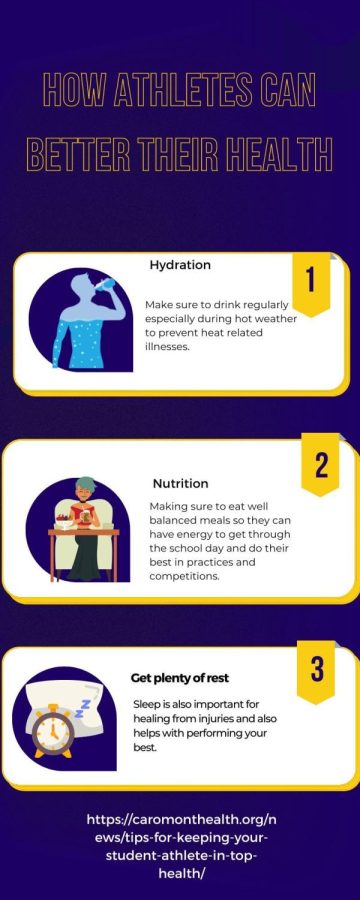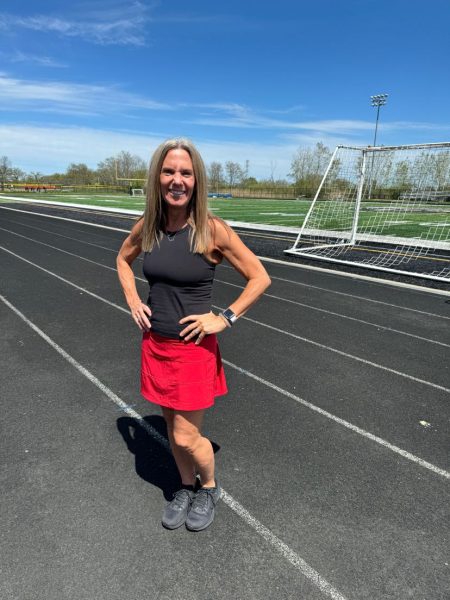Damar Hamlin inspires health, wellness among athletes
The importance of trainers in sports areas has been highlighted since the Damar Hamlin incident that occurred on January 2. The 24 year old Buffalo Bill’s player collapsed on the field in a game against the Bengals. Even though this health issue happened to a professional athlete, high school trainers are important to think about when tragedies like this occur. Not only do athletic trainers help athletes get through injuries, but they are also there for athletes to prevent them.
Caitlyn Bender, an athletic trainer at North, prioritizes the health of athletes every day at work. Bender spends most of her days tending to the athletes and managing issues that happen during and after games and practices.
“I knew in high school that I wanted to be an athletic trainer. I went to Carmel, and they had a student athletic training program. And I saw a friend of mine that was in it, and she was on the football sidelines. And I stopped her, and I was like, what are you doing? I knew I always wanted to help people. I thought I wanted to do physical therapy. But then I saw athletic training. I was like, I’m going to try this like I wanted. I love sports. I love being around sports and love being able to help people, and it was kind of like the perfect combination of all,” said athletic trainer Caitlin Bender.
Bender has seen athletes’ health complications throughout her job as a trainer and understands the impact that sports can have on individuals. Many high school athletes don’t think complications, like the Damar Hamlin incident, can happen to them, but in reality, it can happen to anyone.
“High school athletes in general think they’re invincible, and they think that nothing’s going to happen to them. But the truth of the matter is that it could happen to absolutely anyone, right? It actually happened probably about 12-13 years ago in my hometown. A baseball player was pitching and got a line drive to the chest, and this the same exact thing happened. He collapsed on the mound. And a police officer happened to be driving by and saw it and had an AED in his car and got out of his car and saved his life. Like I mean it just shows us that it can happen. And I think the best thing for all of us to do is to be ready, right? The more people that are CPR and AED trained, the better, and just understanding that there may not always be a medical person right there to help. So you need to know what to do or who to call if something like that were to happen,” Bender said.
Athletes through different sports areas have to consider the impact of what they do can have on their health. While contact sports may face more issues on health risks, many athletes still have to worry about and monitor their health. For sports that take place in the fall, many people need to deal with hot temperatures that can compromise their health and lead to heat exhaustion.
“So it was a really hot day at cross country, and it was like the last possibly 100 meters, and I just wasn’t feeling good, and then like I passed out or I guess I fell. I don’t know if I really passed out in the middle of course. Then I got up and tried to keep running. I couldn’t keep running so I walked to the finish, and then I passed out. After it was really bad. I like didn’t really know what was going on, and I couldn’t feel my legs,” said senior runner Nicole Brown.
“I played golf in high school, and I would say definitely drinking a lot of water because you’re outside walking a lot in really hot temperatures. Also stretching. I feel like stretching for golf is overlooked, but I was always making sure that I was stretching and making sure that if I was hurt, I would ice it or go to the trainers if necessary,” said senior Kelly Eppel.
For many athletes, injuries or mishaps can be unexpected, and for trainers to act quick and help athletes through this is vital. While others might act out under pressure, athletic trainers like the ones at North are helpful and calm when talking and helping athletes. This can be extremely helpful to not worry or stress the athletes and parents.
“They really helped after and checked on me and made sure that I was ready to run instead of forcing me to start right away,” Brown said.
For high school athletes, the trainers not only help them to improve their health while playing their sports, but they are also people that student athletes can talk to about their sport. Many students hang out in the athletic trainers’ office to not only get checked before practice, but also do talk to the trainers about their day.
“I would honestly say they do so much (trainers) for almost every high school athlete. They’re there for every single game and practice, and they’re there every day and helping when the kids are hurting. And they’re people to go too,” Eppel said.
Even though the life of an athletic trainer is difficult on days, there are still days when it can be uneventful. While days that are slow might seem boring to others, athletic trainers realize how important these days are because it means good health for athletes.
“Every day is a new adventure. I think that’s the beauty of high school athletic training is that every day is different. When I walk in, I don’t really know what’s going to happen every day. I, you know, we’ve gone through a lot of training and a lot of schooling to be ready for whatever happens, but we truly just don’t know, right? I mean, a Damar Hamlin situation could happen right there. You know a lot of people are always like commenting sometimes when it’s like a slow day, and I’m like, if it’s a slow day, like, that’s a win for us, right? I mean, you’d rather not see me running all over the place, busy, busy, but I think it’s just, it’s always, it’s not a sit around job. We’re always on the go covering practices, covering games, trying to prevent injury as much as we can and just looking out for the health and safety of all the kids,” Bender said.





